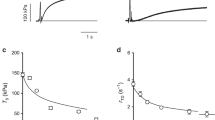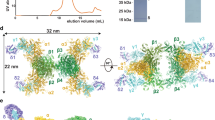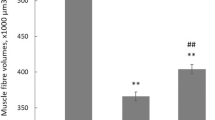Abstract
THE decomposition of creatine phosphoric acid during muscular action, and its rebuilding during rest, has been the subject of numerous detailed investigations. We were interested in the problem, if, and to what extent, creatine phosphoric acid molecules are decomposed and afterwards rebuilt, or ‘rejuvenated’, in the resting muscle. This problem can be easily solved by injecting labelled sodium phosphate, for example, into frogs, and determining if, and to what extent, creatine phosphoric acid extracted from the muscle of the frog becomes labelled (radioactive). Phosphorus atoms present in creatine phosphoric acid and other organic compounds do not exchange spontaneously with other phosphorus atoms present, and thus the fact that labelled creatine phosphoric acid can be isolated from the muscle is a proof that this was synthesized after the administration of labelled sodium phosphate.
This is a preview of subscription content, access via your institution
Access options
Subscribe to this journal
Receive 51 print issues and online access
$199.00 per year
only $3.90 per issue
Buy this article
- Purchase on Springer Link
- Instant access to full article PDF
Prices may be subject to local taxes which are calculated during checkout
Similar content being viewed by others
References
Lohmann, K., Biochem. Z., 194, 306 (1928).
Hahn, L., and Hevesy, G., Bull. Lab. Carlsberg, 22, 188 (1938).
Author information
Authors and Affiliations
Rights and permissions
About this article
Cite this article
HEVESY, G., REBBE, O. Molecular 'Rejuvenation' of Muscle Tissue. Nature 141, 1097–1098 (1938). https://doi.org/10.1038/1411097b0
Published:
Issue Date:
DOI: https://doi.org/10.1038/1411097b0
This article is cited by
-
Der Austausch von radioaktivem,32P-markiertem Orthophosphat mit dem P?, P? und P? von ATP und mit Kreatinphosphat bei Muskelruhe, Temperaturvariation und elektrischer Reizung
Pfl�gers Archiv f�r die Gesamte Physiologie des Menschen und der Tiere (1957)
-
First Benedicks Effect in Gas-Free Mercury, as Influenced by the Mean Temperature
Nature (1940)
-
Diffusion of Phosphate Ions into Blood Corpuscles
Nature (1938)
Comments
By submitting a comment you agree to abide by our Terms and Community Guidelines. If you find something abusive or that does not comply with our terms or guidelines please flag it as inappropriate.



